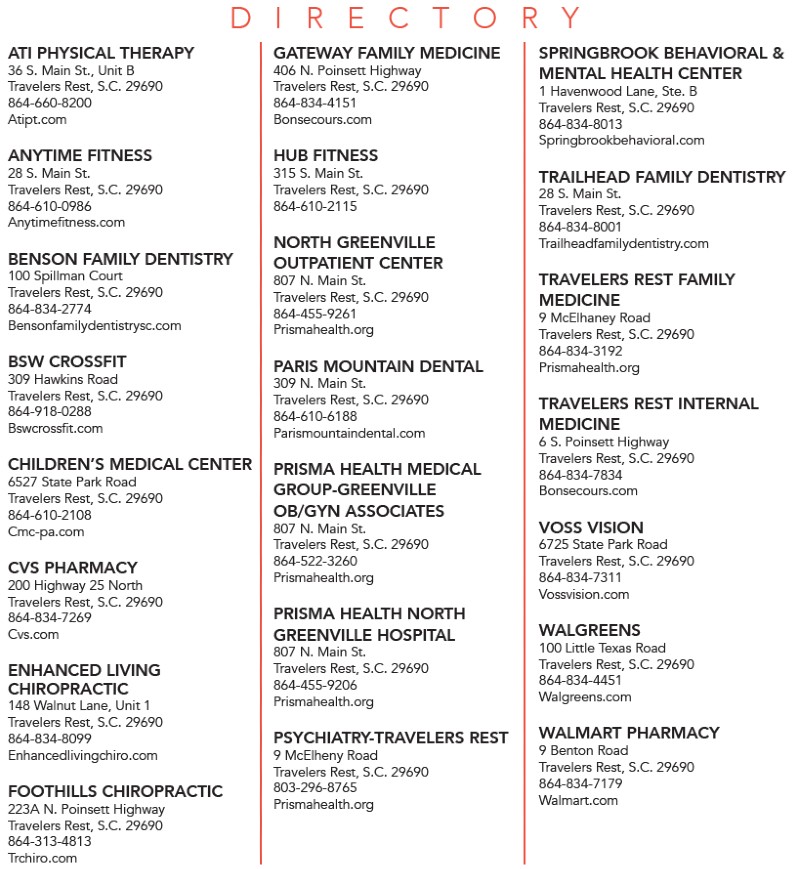Long before its official founding as an Upstate South Carolina city in 1891, Travelers Rest had been a stopover for generations of people traveling by foot, horseback, carriage or train.
And while the mode of traveling eventually came to include automobiles and bicycles, the stop-and-rest attraction remains an integral feature of the city to this day and has helped transform Travelers Rest into sort of a model for movement, healthy living and many forms of health care for now and future generations.
“Travelers Rest is a great place to live, and it is growing rapidly,” said Dr. Rachel Pruitt, who specializes in osteopathic medicine at Gateway Family Medicine, part of the Bon Secours Health System. “And I foresee a greater need for an expansion of health care.”
Part of this need began taking shape with a cooperative effort between Bon Secours and local and state leaders to fill the emergency care gap when North Greenville Hospital’s emergency room closed in 2020.
And with more retirees choosing to live in Travelers Rest, Dr. Pruitt added that an increase in an aging population will require “an increase in routine health care.”
“Travelers Rest, like many small towns, has changed greatly over the course of the last 20 years,” she said. “Small local medical offices have consolidated with local health care systems to provide more continuous care. Our office at Gateway Family Practice works hand-in-hand with our Bon Secours specialist staff and local pharmacists to provide the most complete and comprehensive care possible for our patients.”
The kind of health care most needed now is a far cry from the Travelers Rest of 1891. At that time, the biggest health concerns included pneumonia, tuberculosis, diarrhea and enteritis, and diphtheria, all of which caused about one-third of all deaths in the United States.
Antiseptic surgery to prevent bacterial infection was still a relatively new idea, surgeons were not required to wash their hands before seeing a patient and Alzheimer’s wasn’t even a word. Now it is one of the nation’s top five chronic diseases that physicians in Travelers Rest and every other section of the United States have at the top of their radar for testing, maintaining and researching, and, hopefully, eventually eliminating.
Dr. Pruitt added that the modern health care network between private practices and area hospitals, such as that between Bon Secours and Gateway Family Practice, helps patients get health care for chronic illnesses much faster than even just a generation or so ago.
“Like many communities with an aging population, this network gives providers the tools to be able to help combat many of the chronic problems our patients deal with, such as high blood pressure, diabetes, high cholesterol and respiratory diseases,” she said. “Our goal is to help our patients make healthy choices and receive the treatments they require to enjoy life to the fullest and enjoy the beauty of Northern Greenville County.”
Since March 2020, that health and enjoyment has been somewhat compromised by the ongoing presence of COVID-19 and its variations.
Dr. Glenn Brothers, a primary care physician at Travelers Rest Internal Medicine, said the biggest adjustment its doctors and nurses have had to make during the pandemic is not being able “to see some people in person and changing to a virtual platform.”
“It is our natural instinct to want to see the patient and do a physical exam to assess them,” Dr. Brothers said. “Having to do this virtually via video has taken getting used to on our side and the patients’ side as well. However, it has now provided us with another avenue to see patients that sometimes is more convenient for them, depending on their situation.”
Of course, even COVID hasn’t halted the popularity of one of Travelers Rest’s most health-conscious and fun activities: biking on the Swamp Rabbit Trail.
The 22-mile trail, stretching along a former railroad line from Greenville Technical College to just north of the Travelers Rest city limits, is now utilized each year by more than 500,000 walkers, runners and bicyclists. On any given day of the year, cycling enthusiasts can be seen heading into the city, passing through the city or, more often, stopping for a breather, something to eat or drink or to just take in the sights of the city and the mountains beyond.
Since it opened in 2009, the Swamp Rabbit Trail has not only renewed the time-honored tradition of Travelers Rest as a stopover but most of all has helped the city grow from 4,576 people in 2010 to approximately 5,528 in 2020.
Drs. Pruitt and Brothers both see this growth as indicative of a community aware of its past and using that past to keep Travelers Rest and the surrounding area as a growing health care model through the 2020s.
“Given the growth of the area, I see positive impacts for health care delivery,” Dr. Brothers said. “And I think the health systems acknowledge this, and I feel there will be quite a bit of expansion of health services to the community in the next few years.”
By L. C. Leach III

